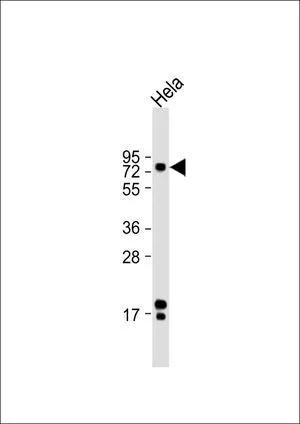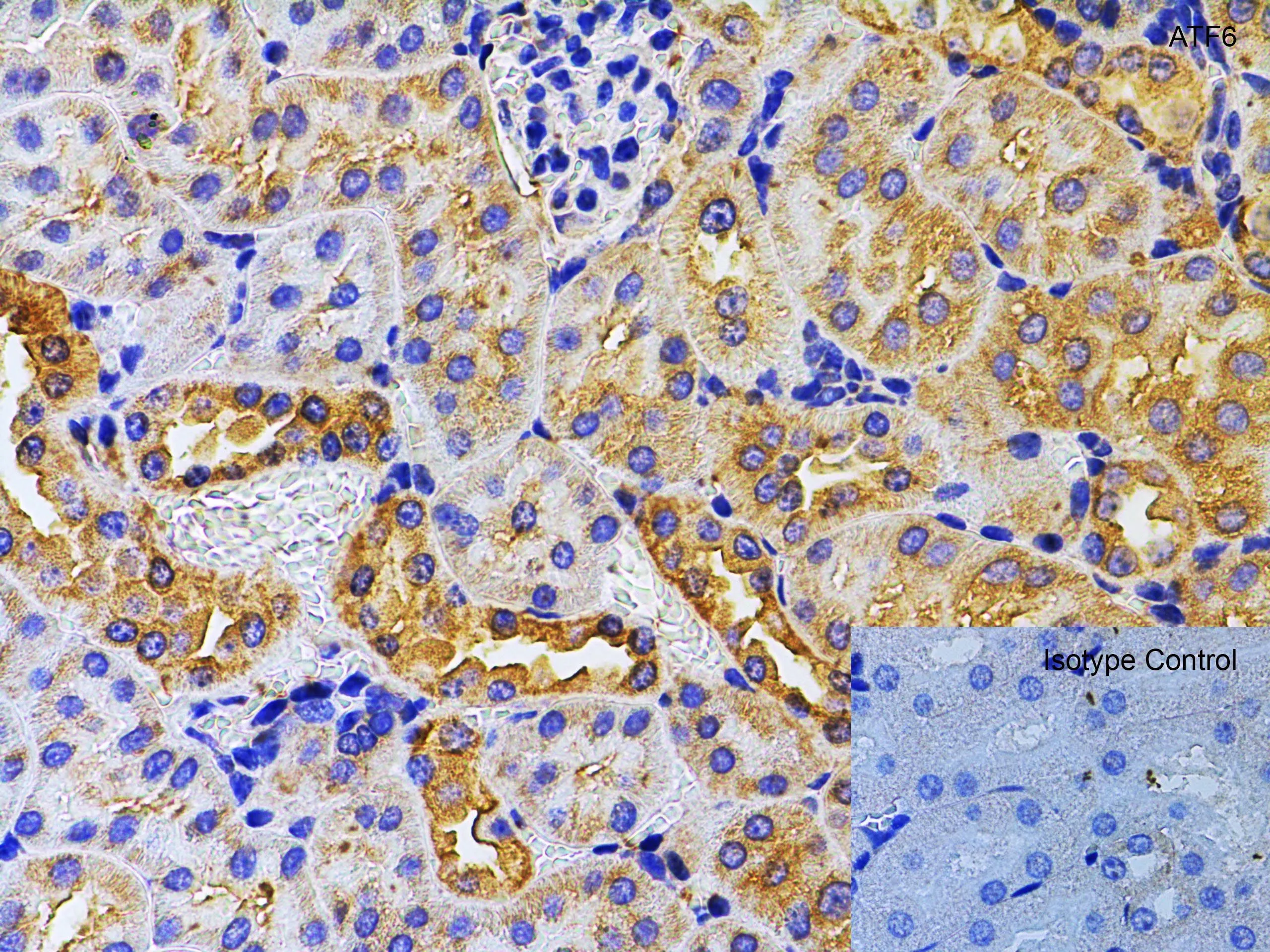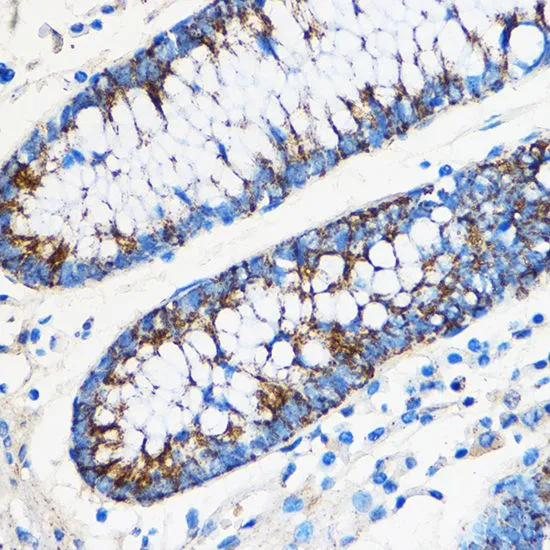![WB analysis of NIH-3T3 cell lysate using GTX00686 ATF6 antibody [37-1]. The asterisk denotes an unglycosylated form of pATF6alpha(P). ATF6alpha is constitutively expressed as pATF6alpha(P), and converted to pATF6alpha(N) ( > 50-kDa protein) in ER-stressed cells. pATF6alpha(P) : the endogenous precursor ATF6alpha (~90kDa) pATF6alpha(N) : the cleaved product of ATF6alpha(>50kDa) Lane 1 : untreated Lane 2 : 1mM DTT (reducing reagent) for 1 h Lane 3 : 2 microg/ml tunicamycin (inhibitor of N-glycosylation) for 3 h Lane 4 : 2 microg/ml tunicamycin (inhibitor of N-glycosylation) for 7 h. Loading : 50microg WB analysis of NIH-3T3 cell lysate using GTX00686 ATF6 antibody [37-1]. The asterisk denotes an unglycosylated form of pATF6alpha(P). ATF6alpha is constitutively expressed as pATF6alpha(P), and converted to pATF6alpha(N) ( > 50-kDa protein) in ER-stressed cells. pATF6alpha(P) : the endogenous precursor ATF6alpha (~90kDa) pATF6alpha(N) : the cleaved product of ATF6alpha(>50kDa) Lane 1 : untreated Lane 2 : 1mM DTT (reducing reagent) for 1 h Lane 3 : 2 microg/ml tunicamycin (inhibitor of N-glycosylation) for 3 h Lane 4 : 2 microg/ml tunicamycin (inhibitor of N-glycosylation) for 7 h. Loading : 50microg](https://www.genetex.com/upload/website/prouct_img/normal/GTX00686/GTX00686_20191104_WB_1_w_23053121_488.webp)
WB analysis of NIH-3T3 cell lysate using GTX00686 ATF6 antibody [37-1]. The asterisk denotes an unglycosylated form of pATF6alpha(P). ATF6alpha is constitutively expressed as pATF6alpha(P), and converted to pATF6alpha(N) ( > 50-kDa protein) in ER-stressed cells. pATF6alpha(P) : the endogenous precursor ATF6alpha (~90kDa) pATF6alpha(N) : the cleaved product of ATF6alpha(>50kDa) Lane 1 : untreated Lane 2 : 1mM DTT (reducing reagent) for 1 h Lane 3 : 2 microg/ml tunicamycin (inhibitor of N-glycosylation) for 3 h Lane 4 : 2 microg/ml tunicamycin (inhibitor of N-glycosylation) for 7 h. Loading : 50microg
ATF6 antibody [37-1]
GTX00686
ApplicationsImmunoPrecipitation, Western Blot
Product group Antibodies
ReactivityHuman
TargetATF6
Overview
- SupplierGeneTex
- Product NameATF6 antibody [37-1]
- Delivery Days Customer9
- Application Supplier NoteWB: 1:500-1:1000. *Optimal dilutions/concentrations should be determined by the researcher.Not tested in other applications.
- ApplicationsImmunoPrecipitation, Western Blot
- CertificationResearch Use Only
- ClonalityMonoclonal
- Clone ID37-1
- Concentration1 mg/ml
- ConjugateUnconjugated
- Gene ID22926
- Target nameATF6
- Target descriptionactivating transcription factor 6
- Target synonymsACHM7, ATF6A, ATP6alpha, cyclic AMP-dependent transcription factor ATF-6 alpha, cAMP-dependent transcription factor ATF-6 alpha
- HostMouse
- IsotypeIgG1
- Protein IDP18850
- Protein NameCyclic AMP-dependent transcription factor ATF-6 alpha
- Scientific DescriptionThis gene encodes a transcription factor that activates target genes for the unfolded protein response (UPR) during endoplasmic reticulum (ER) stress. Although it is a transcription factor, this protein is unusual in that it is synthesized as a transmembrane protein that is embedded in the ER. It functions as an ER stress sensor/transducer, and following ER stress-induced proteolysis, it functions as a nuclear transcription factor via a cis-acting ER stress response element (ERSE) that is present in the promoters of genes encoding ER chaperones. This protein has been identified as a survival factor for quiescent but not proliferative squamous carcinoma cells. There have been conflicting reports about the association of polymorphisms in this gene with diabetes in different populations, but another polymorphism has been associated with increased plasma cholesterol levels. This gene is also thought to be a potential therapeutic target for cystic fibrosis. [provided by RefSeq, Aug 2011]
- ReactivityHuman
- Storage Instruction-20°C or -80°C,2°C to 8°C
- UNSPSC12352203
References
- Mori K. Divest yourself of a preconceived idea: transcription factor ATF6 is not a soluble protein! Mol Biol Cell. 2010,21(9):1435-8.Read this paper

![WB analysis of HeLa cell lysate using GTX00686 ATF6 antibody [37-1]. The asterisk denotes an unglycosylated form of pATF6alpha(P). ATF6alpha is constitutively expressed as pATF6alpha(P), and converted to pATF6alpha(N) ( > 50-kDa protein) in ER-stressed cells. pATF6alpha(P) : the endogenous precursor ATF6alpha (~90kDa) pATF6alpha(N) : the cleaved product of ATF6alpha(>50kDa) Lane 1 : untreated Lane 2 : 1mM DTT (reducing reagent) for 1 h Lane 3 : 2 microg/ml tunicamycin (inhibitor of N-glycosylation) for 3 h Lane 4 : 2 microg/ml tunicamycin (inhibitor of N-glycosylation) for 7 h. Loading : 50microg WB analysis of HeLa cell lysate using GTX00686 ATF6 antibody [37-1]. The asterisk denotes an unglycosylated form of pATF6alpha(P). ATF6alpha is constitutively expressed as pATF6alpha(P), and converted to pATF6alpha(N) ( > 50-kDa protein) in ER-stressed cells. pATF6alpha(P) : the endogenous precursor ATF6alpha (~90kDa) pATF6alpha(N) : the cleaved product of ATF6alpha(>50kDa) Lane 1 : untreated Lane 2 : 1mM DTT (reducing reagent) for 1 h Lane 3 : 2 microg/ml tunicamycin (inhibitor of N-glycosylation) for 3 h Lane 4 : 2 microg/ml tunicamycin (inhibitor of N-glycosylation) for 7 h. Loading : 50microg](https://www.genetex.com/upload/website/prouct_img/normal/GTX00686/GTX00686_20191104_WB_w_23053121_643.webp)
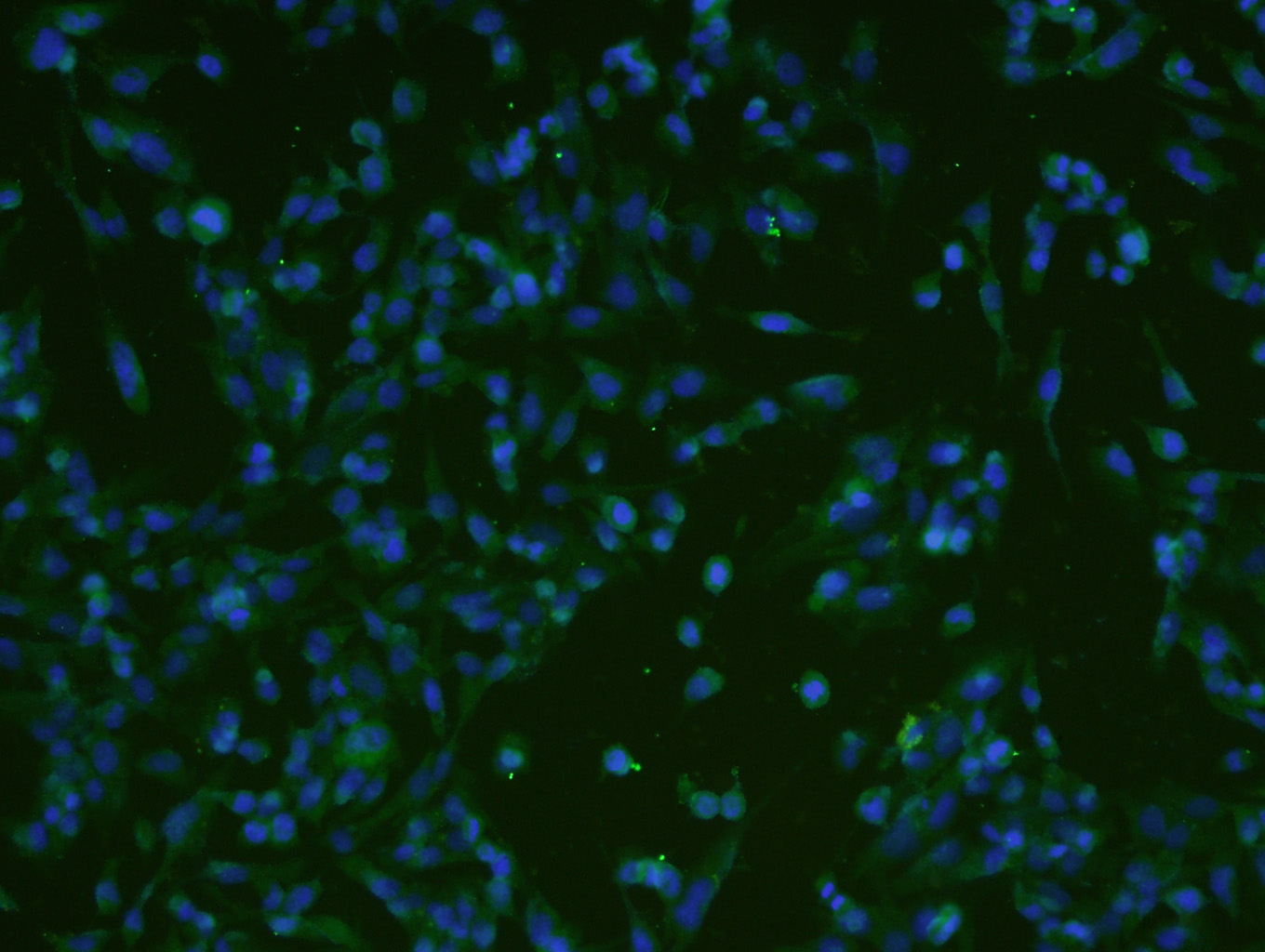

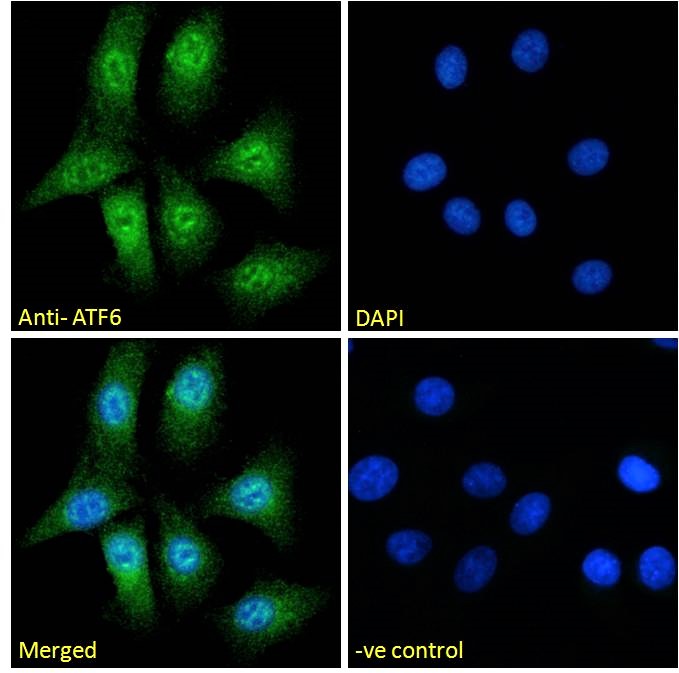

![ICC/IF analysis of HeLa cells using GTX00687 ATF6 antibody [1-7]. Green : Primary antibody Blue : DAPI Dilution : 1:100](https://www.genetex.com/upload/website/prouct_img/normal/GTX00687/GTX00687_20191104_ICC-IF_w_23053121_113.webp)
